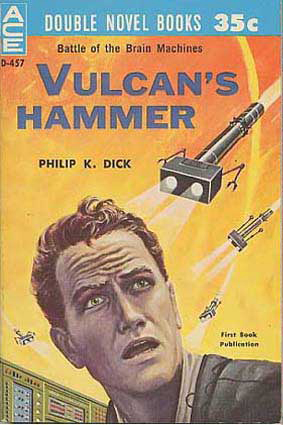Science Fiction
Dictionary
A B C D E F G H I J K L M N O P Q R S T U V W X Y Z
Prodrone Dual Arm Drone PD6B-AW-ARM As Predicted In 1960

Prodrone has introduced its PD6B-AW-ARM drone which has handy robotic arms to accomplish, well, let's say "a variety of tasks".
(Prodrone Dual Arm Drone PD6B-AW-ARM video)
Up to now the industrial and commercial drone market has focused on using drones for photography and filming, mapping, surveying, spraying pesticides, etc., but there is increasingly strong demand for drones to be able to directly perform specific “hands-on” operations.Examples of these operations include the abilities to grasp and carry differently shaped cargo using its arms; to attach or join things; to cut cables; to turn dials; to flick switches; to drop lifesaving buoys; to retrieve hazardous materials, etc. Drones must be able to perform a variety of operations at high altitudes, over long distances, and in places where it would be too dangerous for humans.
The PD6B-AW-ARM is based on PRODRONE’s large capacity PD6B-AW airframe, which has a maximum payload of 20kg (44 lbs.). For the new model the company’s development team designed, produced and attached two high-performance, completely original 5-axis robotic arms. They give the drone versatility to perform across a wide range of situations. The robot arms can carry a maximum payload of approximately 10 kg (22 lbs.), and with flight time of up to 30 minutes, this drone can also excel at longer tasks.
Fans of Philip K. Dick are probably thinking that the surveillance drones from his 1960 novel Vulcan's Hammer are a pretty close match for Prodrone's new dual arm drone PD6B-AW-ARM.

(robot tracking devices from Vulcan's Hammer)
Via Prodrone.
Scroll down for more stories in the same category. (Story submitted 5/13/2017)
Follow this kind of news @Technovelgy.| Email | RSS | Blog It | Stumble | del.icio.us | Digg | Reddit |
Would
you like to contribute a story tip?
It's easy:
Get the URL of the story, and the related sf author, and add
it here.
Comment/Join discussion ( 0 )
Related News Stories - (" Robotics ")
Artificial Skin For Robots Is Coming Right Along
'... an elastic, tinted material that had all the feel and appearance of human flesh and epidermis.' - Harl Vincent (1934)
Robot Guard Dog On Duty
I might also be thinking of K-9 from Doctor Who.
Wearable Artificial Fabric Muscles
'It is remarkable that the long leverages of their machines are in most cases actuated by a sort of sham musculature...' HG Wells, 1898.
Dancing Robots Taught Dance Moves
'A clockwork figure would be the thing for you...' Jerome K. Jerome, 1893.
Technovelgy (that's tech-novel-gee!) is devoted to the creative science inventions and ideas of sf authors. Look for the Invention Category that interests you, the Glossary, the Invention Timeline, or see what's New.
Science Fiction
Timeline
1600-1899
1900-1939
1940's 1950's
1960's 1970's
1980's 1990's
2000's 2010's
Current News
The Zapata Air Scooter Would Be Great In A Science Fiction Story
'Betty's slapdash style.'
Thermostabilized Wet Meat Product (NASA Prototype)
There are no orbiting Michelin stars. Yet.
Could Crystal Batteries Generate Power For Centuries?
'Power could be compressed thus into an inch-square cube of what looked like blue-white ice'
India Ponders Always-On Smartphone Location Tracking
'It is necessary... for your own protection.'
Amazon Will Send You Heinlein's Knockdown Cabin
'It's so light that you can set it up in five minutes by yourself...'
Is It Time To Forbid Human Driving?
'Heavy penalties... were to be applied to any one found driving manually-controlled machines.'
Replace The Smartphone With A Connected Edge Node For AI Inference
'Buy a Little Dingbat... electropen, wrist watch, pocketphone, pocket radio, billfold ... all in one.'
Artificial Skin For Robots Is Coming Right Along
'... an elastic, tinted material that had all the feel and appearance of human flesh and epidermis.'
Robot Guard Dog On Duty
I might also be thinking of K-9 from Doctor Who.
Wearable Artificial Fabric Muscles
'It is remarkable that the long leverages of their machines are in most cases actuated by a sort of sham musculature...'
BrainBridge Concept Transplant Of Human Head Proposed
'Briquet’s head seemed to think that to find and attach a new body to her head was as easy as to fit and sew a new dress.'
Google's Nano Banana Pro Presents Handwritten Math Solutions
'...copy was turned out in a charming and entirely feminine handwriting.'
Edible Meat-Like Fungus Like Barbara Hambly's Slunch?
'It was almost unheard of for slunch to spread that fast...'
Sunday Robotics 'Memo' Bot Has Unique Training Glove
'He then started hand movements of definite pattern...'
Woman Marries Computer, Vonnegut's Dream Comes True
'Men are made of protoplasm... Lasts forever.'
Natural Gait With Prosthetic Connected To Nervous System
'The leg was to function, in a way, as a servo-mechanism operated by Larry’s brain...'
